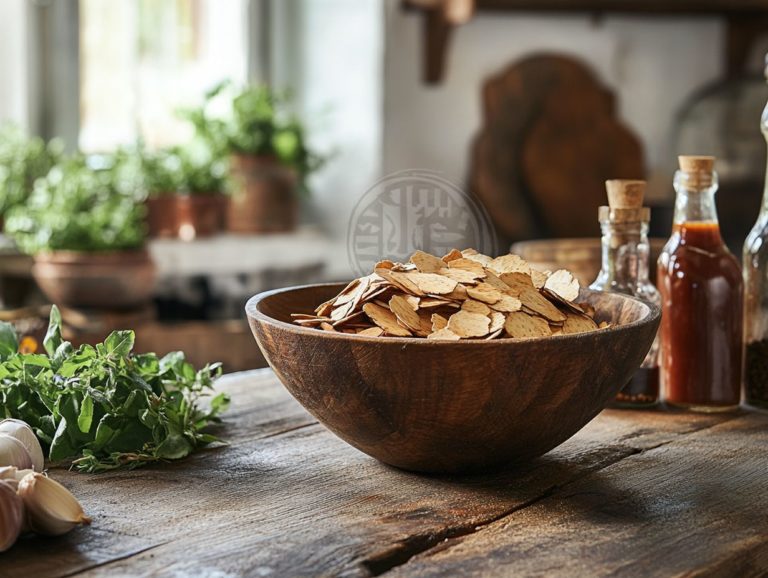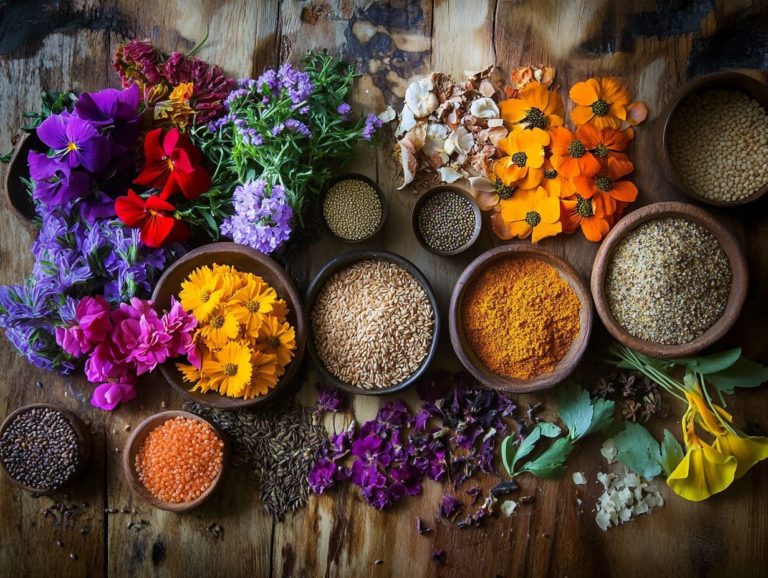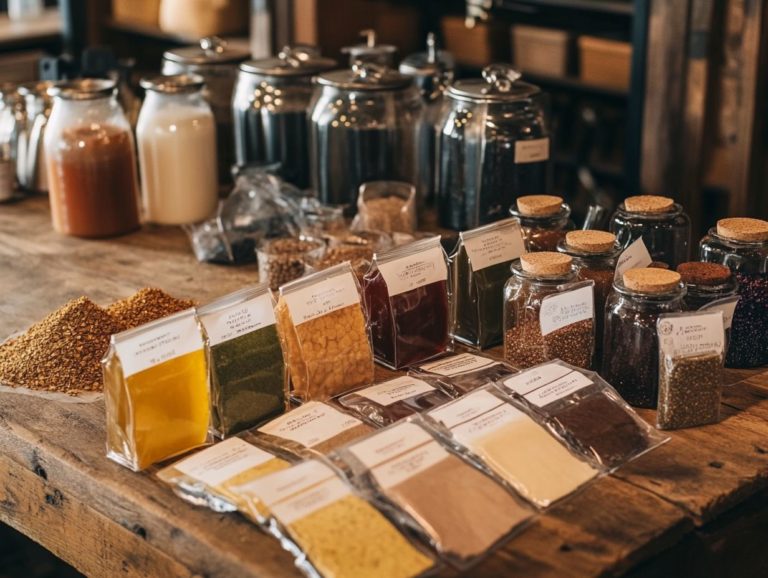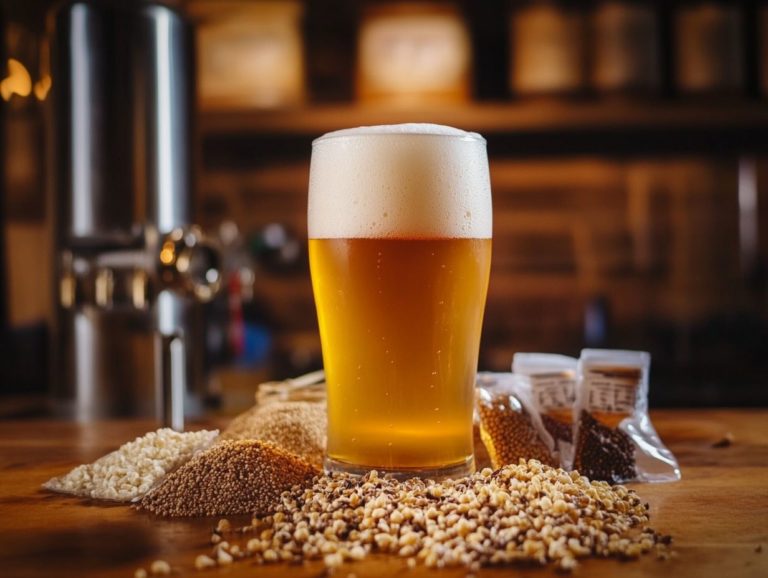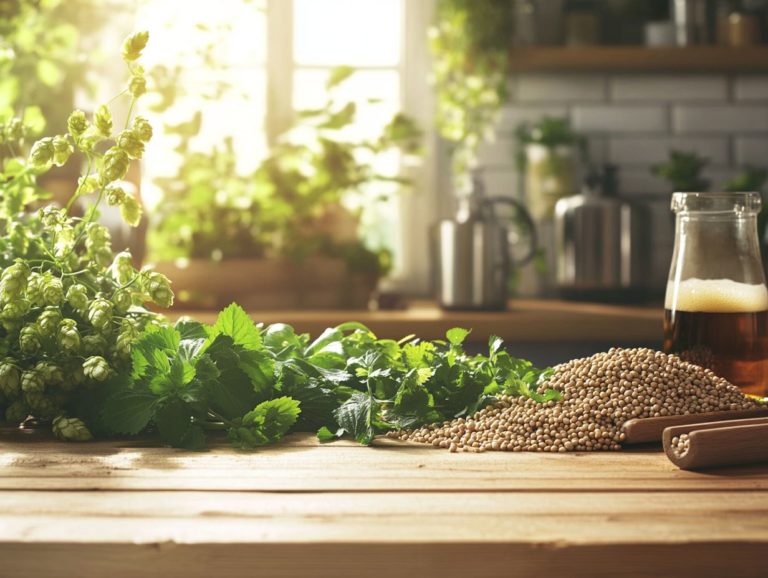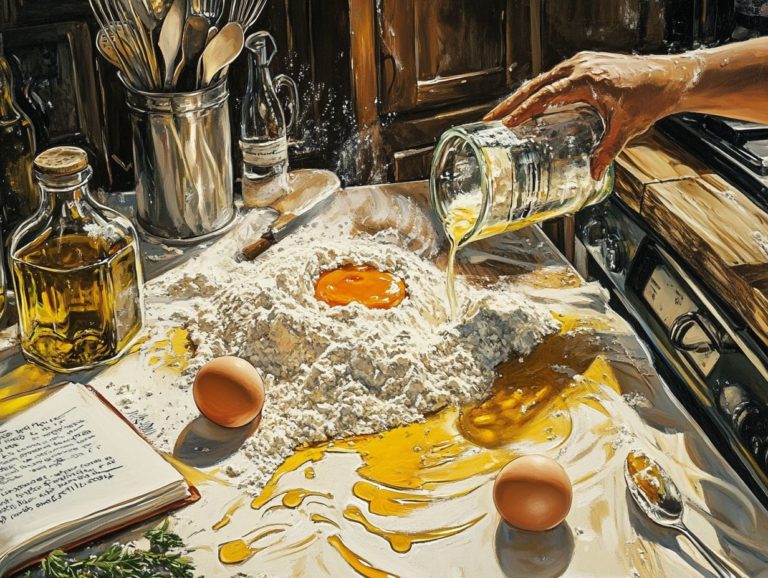How to Use Sugar for Brewing Different Styles
Understanding the role of sugar in brewing plays a crucial role in your journey as an aspiring brewer. From fermentation to flavor and carbonation, sugar and other fermentable sugars like dextrose and sucrose emerge as key players in your quest to craft the perfect brew.
This article will take you on a journey through the various types of sugar used in brewing and their influence on different beer styles, such as Belgian beers and American IPAs. You will also discover practical tips for utilizing sugar and adjuncts like molasses and honey effectively in your brewing endeavors.
We will highlight common pitfalls to avoid, ensuring that your brewing process is not only enjoyable but also successful.
Are you ready to dive into the sweet science of brewing?
Contents
- The Art of Carbonation in Beer Brewing
- Understanding Dark Beer Styles and Homebrewing Tips
- Tips for Using Sugar in Homebrewing
- Adjusting Flavor and Carbonation
- Common Mistakes to Avoid when Using Sugar in Brewing
- Common Brewing Mistakes
- Frequently Asked Questions
- What types of sugar can be used for brewing different styles?
- How much sugar should I use when brewing?
- Can I substitute different types of sugar in a recipe?
- When should I add sugar during the brewing process?
- What styles of beer work well with different types of sugar?
- Can I use sugar to increase the alcohol content of my beer?
Key Takeaways:
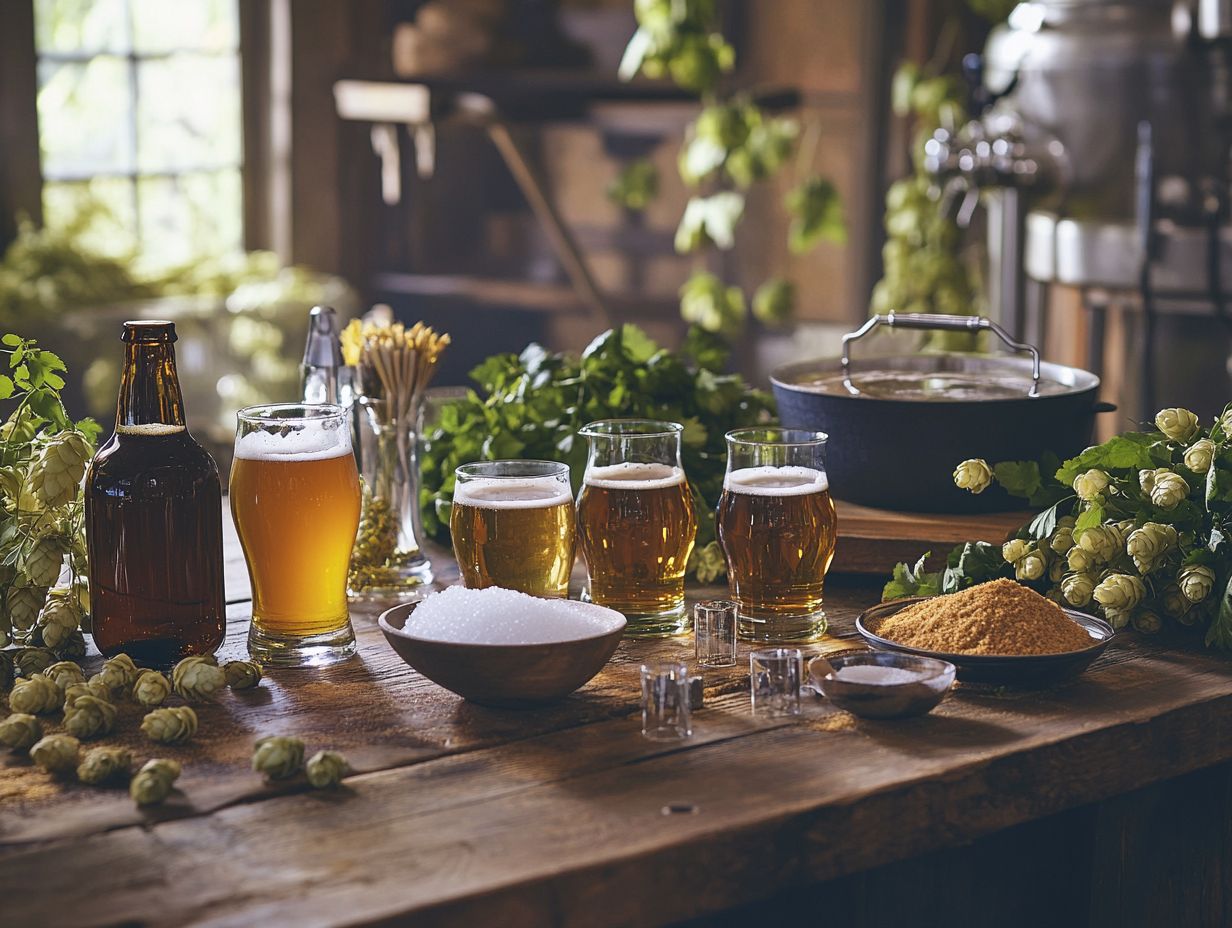
- Sugar plays a crucial role in brewing as it affects fermentation, flavor, and carbonation.
- When using sugar in different beer styles, such as Belgian beers and American IPAs, it is important to consider its impact on the final product, including factors like alcohol content and flavor profile.
- To successfully use sugar in brewing, accurate measurement, proper fermentation control, and careful flavor adjustments are key. Avoid common mistakes like using the wrong amount or type of sugar, such as maltodextrin or invert sugar, and neglecting fermentation monitoring.
What is Sugar?
Sugar is a complex ingredient that comes in various forms, each adding its unique traits to the brewing process. You’ll encounter common types like dextrose, sucrose, and brown sugar, alongside more specialized options such as Belgian candi sugar, maple syrup, maltodextrin, agave nectar, and invert sugar.
These sugars do more than just act as ingredients that yeast can eat during fermentation; they also play a crucial role in shaping the flavor profile and sweetness of your final beverage. Additionally, sugars derived from sources like molasses, honey, lactose, and malt extract serve as adjuncts, offering distinct flavor nuances and brewing advantages.
Grasping the intricacies of these types is vital for any homebrewer aspiring to craft specific beer styles with finesse.
Types of Sugar Used in Brewing
In brewing, you have a delightful array of sugars to enhance fermentation performance and add layers of flavor complexity. Dextrose and sucrose are your go-to choices for fermentability. Brown sugar and invert sugar bring rich flavors and coloring to the mix. Specialty sugars, like Belgian candi sugar, offer unique characteristics that shine, especially in Belgian beers.
On the other hand, molasses and honey introduce their own distinct profiles, elevating your craft beer experience. If you’re brewing milk stouts, don’t overlook lactose this non-fermentable sugar creates a creamy mouthfeel that s simply irresistible. Additionally, malt extract serves as a robust foundation for many homebrew recipes.
These sugars are crucial not just for fermentation but also for defining the mouthfeel, aroma, and overall balance of your final product. For example, dextrose and sucrose ferment completely, often boosting the alcohol content while leaving no residual sweetness behind. Brown sugar, on the flip side, adds rich flavor complexity and darker hues to your brew.
Then there’s Belgian candi sugar, which can impart a distinctive fruity and spicy character, particularly coveted in traditional styles. Incorporating molasses into stouts or porters can lend a deep richness, highlighting the delightful dance between sweetness and bitterness.
Understanding how each sugar influences gravity points and contributes unique flavors is essential for any brewer seeking to craft exceptional beers with a diverse range of profiles.
In conclusion, experimenting with different sugars can elevate your brewing game and allow you to craft unique and flavorful beers. Happy brewing!
How Does Sugar Affect the Brewing Process?
Sugar is essential in the brewing process, significantly impacting fermentation, alcohol content, and the overall flavor profile of the beer you enjoy.
During fermentation, yeast consumes fermentable sugars such as glucose and maltose, producing alcohol and carbon dioxide as byproducts. This is critical for achieving the carbonation levels you desire.
The specific type of sugar you choose can influence not only the final alcohol content but also the sweetness and complexity of the beer. For example, incorporating priming sugar at bottling can elevate carbonation. Other sugars like table sugar or honey can impart unique flavors that enhance the final product, giving you a truly exceptional brew.
Fermentation Process in Homebrewing
Fermentation is a pivotal phase in your brewing journey. During this stage, yeast works its magic by converting sugars into alcohol and carbon dioxide, fundamentally transforming the beer’s essence. The type of sugar you choose be it glucose or maltose can significantly influence the fermentation rate and the final alcohol content of your brew.
Opting for highly fermentable sugars can accelerate the process, resulting in a drier beer. In contrast, less fermentable sugars may yield a sweeter profile. The yeast strain you select is equally critical; it determines how effectively those sugars are converted, ultimately shaping both taste and mouthfeel.
The fermentation process is a delicate dance of scientific precision and creative artistry. As yeast devours sugar, it produces alcohol and releases a variety of esters and phenols that contribute to your beer’s flavor profile. This makes your choice of sugar not just about hitting a specific alcohol target; it also dictates the aromatic qualities that will emerge in your final brew.
Experimenting with sugar cane can provide distinct aromatic qualities. Craft brewers love to push boundaries by experimenting with unconventional sugars like honey or fruit to infuse unique characteristics. Understanding how these sugars interact with different yeast strains is vital for optimizing fermentation results. By grasping this intricate relationship, you can expertly craft beverages that resonate with a wide array of palates.
Flavor
The flavor profile of your beer is significantly influenced by the types of sugars you choose during brewing. These sugars contribute not just sweetness but also a spectrum of complex flavors. For instance, incorporating honey can impart unique aromatic qualities, while adjuncts like molasses or Belgian candi sugar can add depth and richness.
The selection of sugar doesn t merely affect the sweetness level; it also plays a crucial role in shaping the malt character, balancing bitterness, and enhancing your overall tasting experience. Understanding how different sugars interact with other ingredients is essential for crafting beers that boast the desired flavor attributes and complexity.
The variety of sugars you incorporate during the brewing process creates an intricate relationship with hops and malts, ultimately shaping the overall balance of flavors. Take lactose, for example; when used, it allows you to create creamier textures and sweeter flavors that beautifully complement hoppy bitterness.
Adjuncts like oats or corn syrup can also enhance mouthfeel and sweetness, supporting the beer s body while harmonizing with the underlying malt backbone. These ingredients empower you to unleash your creativity, experimenting with diverse beer styles.
This experimentation enriches the drinking experience, inviting enthusiasts to savor your unique offerings. Whether you re brewing a rich stout or a crisp lager, the possibilities are limitless.
In conclusion, understanding the profound effects of sugar on brewing is crucial for any brewer. By exploring and experimenting with various sugars, you can elevate your brewing practices, creating beers that are not only enjoyable but also memorable.
The Art of Carbonation in Beer Brewing
Carbonation
Carbonation is a crucial element of beer that hinges on the sugars used during brewing, particularly the sugar added before sealing the bottles. This sugar ferments in a sealed bottle, producing carbon dioxide, which is key to achieving that delightful fizz.
The type and amount of sugar you select whether it’s priming sugar, table sugar, or maple syrup determine the carbonation level and influence the mouthfeel of the finished brew. This makes sugar selection an essential consideration in your brewing journey.
Effectively managing carbonation can elevate your overall drinking experience, enhancing the beer’s freshness and complexity.
When choosing the right sugar, you have a range of options at your disposal, like corn sugar, table sugar, or even more unique choices such as honey or maple syrup. Each option introduces its own distinct flavor profile and fermentation characteristics, which can enhance or transform the beer’s final presentation.
The texture of the beer whether it feels silky, creamy, or sharp on the palate can be significantly impacted by the carbonation level, contributing to its overall mouthfeel. Ultimately, careful selection and management of sugars, such as agave nectar, are vital for achieving your carbonation goals and refining your enjoyment while enhancing the beer’s character.
Using Sugar in Different Styles of Beer
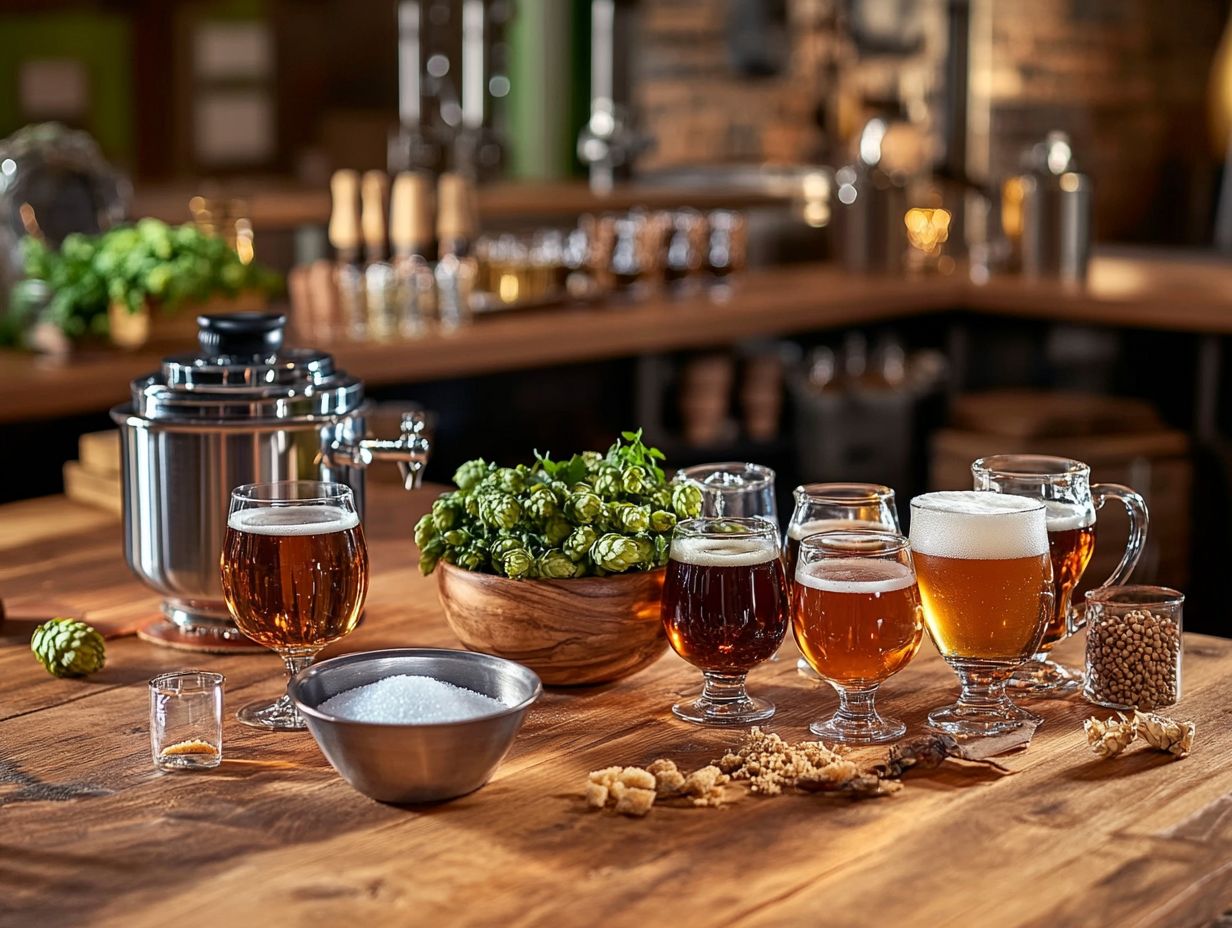
Different styles of beer harness sugars in unique ways to elevate their distinct characteristics and flavor profiles.
For instance, when exploring Belgian beers, you’ll notice the use of Belgian candi sugar, which infuses fruity and spicy notes into the brew. English ales, on the other hand, often incorporate brown sugar to add richness and caramel flavor that you can savor.
Using lighter sugars in German lagers achieves a crisp, clean finish. In contrast, American IPAs tend to focus less on sugar and highlight hop flavors that are bold and vibrant.
Stouts and porters frequently embrace lactose and other brewing sugars such as dextrose and maltose, creating creamy textures and enhancing sweetness. This showcases just how versatile sugars can be across various beer styles.
Belgian Beers
Belgian beers are celebrated for their distinctive flavor profiles, often crafted through the use of sugars like Belgian candi sugar and invert sugar during the brewing process. These sugars support fermentation and impart unique fruity and spicy notes that define Belgian styles.
Whether you’re indulging in a tripel or a quad, brewers utilize various types of sugar to enhance complexity and depth, resulting in beers that are both rich and aromatic. The fermentation process, influenced by these sugars, creates a delightful balance between sweetness and alcohol strength.
Incorporating candi sugar and honey can significantly transform the beer’s mouthfeel and overall drinkability, providing a smooth experience that cleverly masks the higher alcohol levels typically found in stronger Belgian varieties.
Styles like Dubbel and Saison showcase these qualities beautifully, while recipes for popular brews such as Chimay Blue or Westmalle Dubbel highlight the essential role of this sweetener.
By adjusting the quantity and type of candi sugar and other sugar types, brewers can craft a wide array of flavors, from caramel and toffee notes to subtle hints of dark fruits, making each brew a unique testament to the rich tradition of Belgian brewing.
English Ales
English ales often use sugars like brown sugar and table sugar to enhance their malt character. This introduces a delightful richness that beautifully complements the overall profile of the style.
This sweetness harmonizes with the bitterness from hops, crafting a well-rounded beer experience. The caramel notes from brown sugar enhance the ale’s complexity, making it both approachable and flavorful.
Many traditional English ale recipes depend on this sugar to achieve the essential balance and richness that define the style. Alongside brown sugar, varieties such as muscovado, sucrose, and pale malt extract play crucial roles in creating these ales.
Each sugar type contributes unique characteristics; for instance, muscovado brings a subtle molasses flavor, enriching both aroma and mouthfeel. Try the classic English Mild Ale or the robust Old Ale, perfect for cozy evenings and lively gatherings!
The interplay of sugars not only amplifies richness but also ensures a smooth finish. This makes every sip both satisfying and unforgettable.
German Lagers
German lagers offer a clean, crisp taste that you can truly appreciate. This is crafted through the meticulous selection of sugars, malt extracts, and dextrose a simple sugar.
Fermentable sugars are essential for producing alcohol, and the real artistry lies in achieving a balance that accentuates the malt profile without drowning it out. These lagers use lighter sugars for fermentation, allowing the malt flavors to shine brilliantly.
The result is a refreshing beer that you ll love, reflecting the precision that defines German brewing methods and careful management of fermentable sugars.
The interaction of sugars in these brews affects not just sweetness; it also plays a pivotal role in the overall mouthfeel and finish. For example, recipes like Helles and M rzen often blend pilsner malts with caramel or Munich malts, adding a subtle sweetness that creates a delightful harmony of flavors.
By managing sugar levels, brewers ensure that the final product boasts a clean taste profile. This allows you to savor the delicate nuances of each batch. This thoughtful approach to sugar selection defines the authenticity of German lagers, making them a cherished choice among beer enthusiasts worldwide.
American IPAs
American IPAs often place a premium on hop flavors, leaving sweetness in the background. However, the choice of sugars still plays a subtle yet essential role in achieving that perfect balance.
Typically, the use of sugars is kept to a minimum, as brewers aim for hop bitterness and aroma to take center stage. Yet, certain adjunct sugars additional sugars used to enhance flavor or body like corn syrup and maltodextrin can be introduced to impart a delicate malt character.
This rounds out the beer without eclipsing those vibrant hops, which is crucial in crafting the bold and lively profile that defines American IPAs.
While many brewers stick with classic malted grains, they might also venture into various sugars, like corn syrup, candied sugars, or glucose, to introduce complexity without compromising the hop character.
A favored technique is to integrate simple sugars during fermentation, providing the yeast with a boost and contributing to a drier finish. Some esteemed IPA recipes even embrace caramel or crystal malt sugars, and even honey flavors, adding a whisper of sweetness that elegantly supports the intense hop flavors.
Ultimately, this thoughtful selection of sugars enhances the overall flavor profile, creating a well-rounded and delightful drinking experience for those who appreciate the intricacies of a fine IPA.
Understanding Dark Beer Styles and Homebrewing Tips
Stouts, Porters, and Other Dark Beer Styles
Stouts and porters are celebrated for their rich, dark flavors, often achieved through the inclusion of sugars like lactose, maple syrup, and agave nectar. This non-fermentable sugar adds a delightful sweetness and creaminess.
It enriches the mouthfeel and creates a fuller, more satisfying experience. You might find brewers using brown sugar or molasses to impart complex flavors that elevate the beer’s overall character. The interaction between these sugars and darker malts results in a well-rounded, indulgent drinking experience.
As these sugars interact with the roasted malts, subtle hints of caramel and chocolate emerge, leading to a beautifully layered flavor profile. Many enthusiasts delight in experimenting with recipes that showcase these unique characteristics. For instance, a popular oatmeal stout often incorporates flaked oats alongside lactose, resulting in a velvety texture that enhances its dessert-like quality.
When brewers craft a milk stout, they frequently turn to rich caramel flavors derived from brown sugar. This creates a delightful balance of sweetness and bitterness that tantalizes the palate and keeps drinkers coming back for more.
Tips for Using Sugar in Homebrewing
Successfully incorporating sugar, such as priming sugar or table sugar, into your brewing process requires meticulous measurement. A deliberate approach is needed to achieve the desired fermentation and flavor outcomes.
Precision is paramount when measuring sugars; utilizing a scale ensures you add the correct amount, whether you re working with priming sugar or fermentation sugars. Managing fermentation conditions is also important, such as temperature and yeast health. These factors play a crucial role in how effectively sugars are converted into alcohol and carbon dioxide.
The type of sugar you choose can dramatically influence the final flavor and mouthfeel of your beer, allowing you to craft a truly exceptional brew.
Measuring and Adding Sugar
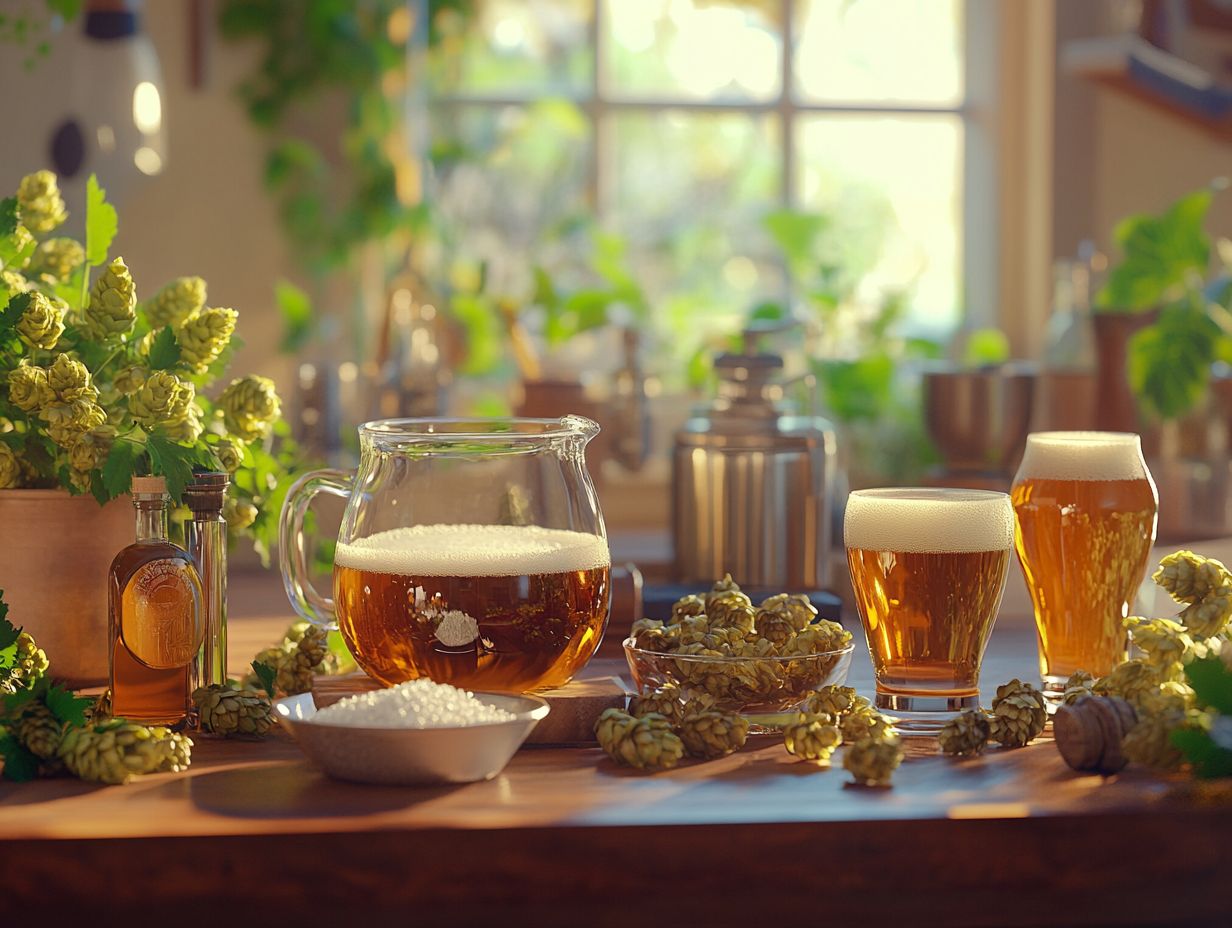
Measuring and adding sugar with precision is essential for achieving the perfect fermentation and carbonation levels in your homebrew. Using adjuncts like agave or sucrose can also influence the final product.
For priming sugar, calculate the amount based on your batch size and the carbonation level you aim to reach. Utilize a reliable calculator to avoid the pitfalls of over or under-carbonation.
Timing is key. Adding sugars at the right moment during fermentation can significantly influence yeast activity and flavor development, making it crucial for you to understand when and how to incorporate them effectively. Consider monitoring gravity points to track the fermentation progress.
Employing tools like a hydrometer or refractometer is invaluable for gauging the specific gravity of your beer. This enables you to make precise adjustments to your sugar additions, thus ensuring optimal fermentation performance.
As you add sugar at various stages of fermentation whether at the beginning, during, or close to the end consider how these additions will impact the overall flavor profile and aroma of your final product.
Dissolving sugar in a small amount of water first is a game-changer! It prevents clumping and guarantees that every sip of your brew is perfectly balanced.
Keeping a close eye on fermentation temperature and timing your sugar additions meticulously can enhance yeast performance. This leads to optimal carbonation levels and a complex, exceptionally refined taste experience.
Experiment with sugar additions in your brewing to discover unique flavors and elevate your craft beer game!
Controlling Fermentation
Controlling fermentation is vital for attaining the precise alcohol content and flavor profile in your beer. Sugar levels and types, such as sucrose and maltodextrin, play a pivotal role. By monitoring yeast health and activity, you can ensure that the sugars are converted effectively. This directly impacts the final alcohol percentage and the overall taste of your brew.
You may find that adjustments are necessary as fermentation progresses. This includes managing temperature and selecting the right types of sugars, like agave nectar or malt extract, to maintain the desired fermentation dynamics throughout the brewing process.
Successful fermentation demands your attention to temperature, as yeast is remarkably sensitive to fluctuations. If the temperature soars too high or dips too low, you risk introducing unpleasant tastes or encountering stuck fermentation, both of which can significantly alter your final product. Always check the gravity points to ensure proper progression.
The choice of sugars, such as maltose from malted grains or options like honey or corn syrup, can dramatically affect the beer’s body and mouthfeel. Different sugars ferment at varying rates and lend distinct flavor profiles, resulting in unique and crafted beverages.
To strike the perfect balance, you ll want to conduct regular checks, making necessary adjustments to support healthy yeast behavior and ensure optimal fermentation progress.
Adjusting Flavor and Carbonation
When you adjust the flavor and carbonation in your beer, it s essential to give careful thought to the sugars you employ during the brewing process, especially the priming sugar added at bottling. The type of sugar you choose can bring various sweetness levels and flavors to the table, significantly influencing the final taste and mouthfeel of your brew.
Getting the right amount of priming sugar is critical; too much can lead to over-carbonation, resulting in bad flavors and an unpleasant drinking experience.
You have a range of sugar options at your disposal corn sugar, table sugar, and even more adventurous choices like honey or maple syrup that can dramatically alter your beer’s profile. For example, corn sugar typically yields a cleaner profile and is easily fermentable, leading to a drier finish. On the other hand, honey adds floral notes and complexity that can elevate your brew. If you opt for brown sugar, you ll introduce hints of caramel and molasses, which can deepen the richness of darker beers.
Don’t forget to consider how these sugars interact with the yeast it s this interplay that makes crafting your perfect beer an art! Different strains may highlight or soften certain flavors, showcasing the artistry involved in creating a well-rounded beer experience.
Common Mistakes to Avoid when Using Sugar in Brewing
When utilizing sugar in brewing, you must be vigilant about common mistakes that could compromise the quality of your beer. One of the most prevalent errors is miscalculating the amount of sugar either too much or too little which can significantly influence fermentation levels and, consequently, the alcohol content.
Furthermore, overlooking the type of sugar you use can create imbalances in flavor and sweetness. Additionally, failing to monitor the fermentation process closely may lead to undesirable bad flavors or result in under-carbonated beer. Stay attentive to these details to achieve the perfect brew.
So, as you embark on your brewing journey, remember to experiment and enjoy the process. Each batch offers a new opportunity to create something special!
Common Brewing Mistakes
Using Too Much or Too Little Sugar
Using too much or too little sugar during brewing can create significant issues, impacting both fermentation and the final alcohol content of your beer. If you add excessive sugar, you risk overwhelming the yeast, which can lead to stuck fermentation or an overly sweet brew. On the flip side, not adding enough sugar can result in a disappointing low alcohol percentage and a lackluster flavor.
Understanding the proper measurements and types of sugar is essential for maintaining balance and achieving the intended results in your creation. The consequences of miscalculating sugar amounts go beyond mere numbers; they can fundamentally alter the overall experience of your beverage.
Fermentation challenges often stem from the yeast’s struggle to process an overload or scarcity of sugars, leading to undesirable off-flavors and aroma profiles.
Use accurate measuring tools like scales or graduated cylinders to ensure precision. Familiarize yourself with the specific types of sugar you re incorporating. This meticulous attention to detail can dramatically enhance your brewing process, enabling consistent and enjoyable results that align with your expectations.
Not Considering the Type of Sugar
Neglecting to consider the type of sugar you use in brewing can lead to missed opportunities for elevating both flavor and fermentation performance. Different sugars like brown sugar, dextrose, or lactose bring their own unique characteristics and sweetness levels to your beer. Misjudging the sugar type can create imbalances in flavor and sweetness, ultimately affecting the quality of your final product.
It s crucial for you to understand the unique traits of each sugar type to craft the beer profile you desire.
Take brown sugar, for example. It can introduce delightful hints of caramel and molasses, making it especially fitting for styles like stouts and porters, where depth and complexity are key. In contrast, dextrose is a simple sugar that ferments quickly and cleanly, making it the go-to for lighter beers such as lagers, where a crisp finish is essential.
Then there s lactose, a non-fermentable sugar that imparts creaminess and residual sweetness ideal for milk stouts or dessert beers that aim for a fuller mouthfeel. The unique properties of each sugar not only shape the taste but also play a vital role in the overall mouthfeel and appearance of your beer.
Not Monitoring Fermentation
Neglecting to monitor fermentation can lead to a host of problems that compromise the quality of your beer, particularly when it comes to yeast activity and sugar conversion. Without regular checks, you may miss signs of a stuck fermentation, resulting in off-flavors or unexpected sweetness.
Understanding the fermentation process and closely observing yeast health is crucial for ensuring that sugars are effectively converted into alcohol and carbon dioxide, paving the way for a successful brew.
For outstanding results, keep a close eye on your fermentation process! It s essential for you to routinely check specific gravity, ideally using a hydrometer or refractometer. These readings provide valuable insight into the fermentation’s progression.
Paying attention to yeast behavior such as its flocculation and activity levels allows you to detect potential issues early on. By maintaining a consistent schedule for these checks and documenting your findings, you can make timely adjustments, ensuring that fermentation stays on track.
Implementing these best practices not only helps you achieve the desired flavor profile but also enhances your overall brewing confidence.
Frequently Asked Questions
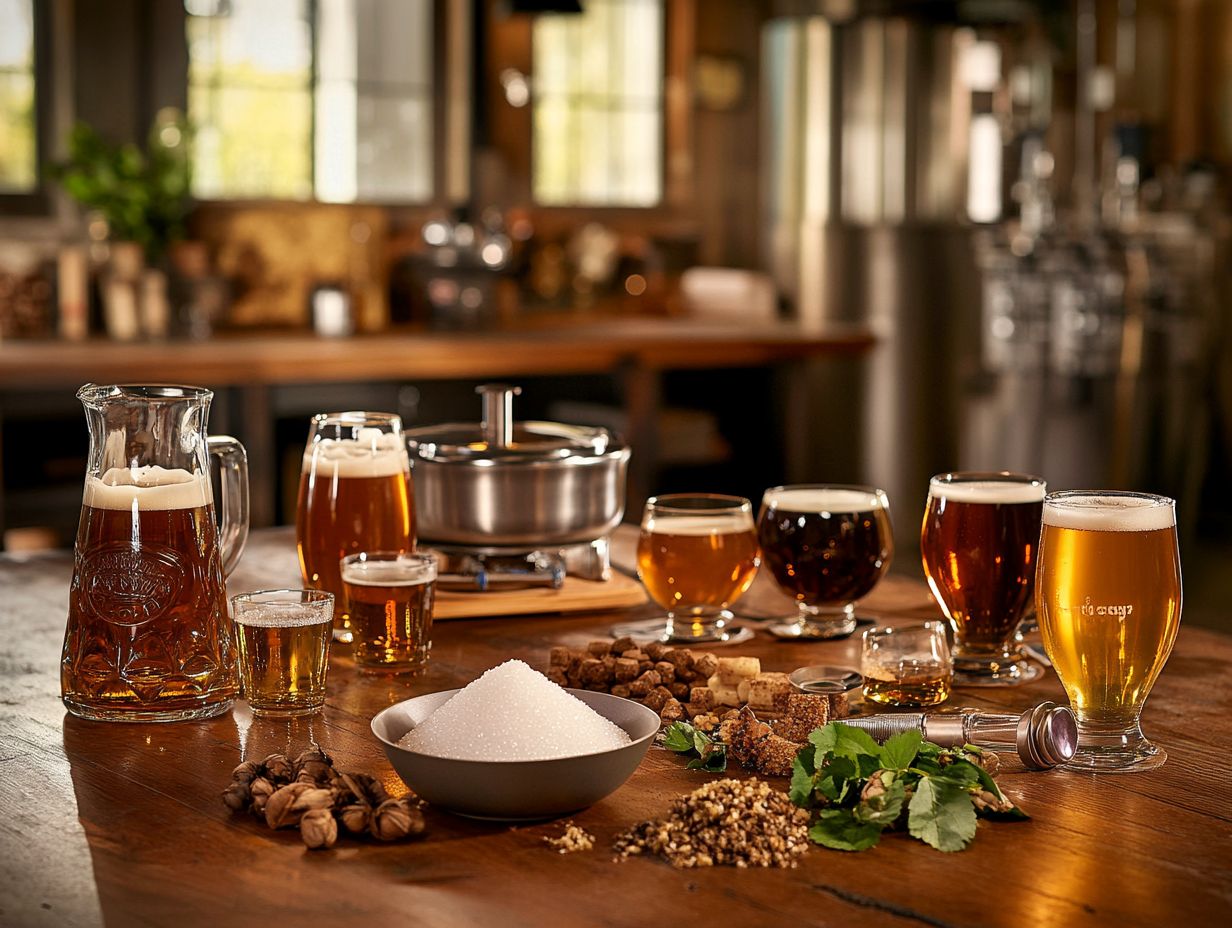
What types of sugar can be used for brewing different styles?
There are several types of sugar that can be used for brewing different styles, including table sugar, brown sugar, honey, and molasses. Each type can add unique flavors and characteristics to your beer.
How much sugar should I use when brewing?
The amount of sugar to use when brewing depends on the specific style and recipe. It is important to carefully measure and follow the recipe to avoid over or under-sweetening your beer.
Can I substitute different types of sugar in a recipe?
Yes, you can substitute different types of sugar in a recipe, but it may alter the flavor and characteristics of your beer. It is best to experiment with small batches before making a larger batch with a substituted sugar.
When should I add sugar during the brewing process?
When to add sugar in brewing depends on your recipe and style. Some sugars may be added during the boil, while others are added during fermentation.
Follow the recipe instructions for the best results.
What styles of beer work well with different types of sugar?
Different styles of beer pair well with various types of sugar. For example, Belgian Dubbel and Tripel styles often use candi sugar, which is a type of sugar commonly used in brewing that adds flavor and color. Meanwhile, Porters and Stouts may use molasses for added depth and complexity.
Can I use sugar to increase the alcohol content of my beer?
Absolutely! Adding sugar boosts the alcohol content of your beer, giving it an exciting kick! However, carefully measure and add the sugar in small amounts to avoid creating an unbalanced and overly alcoholic beer.

